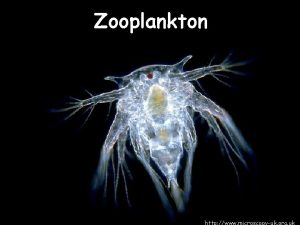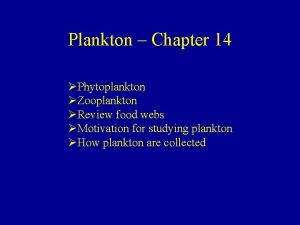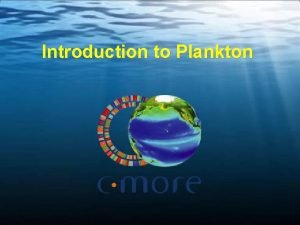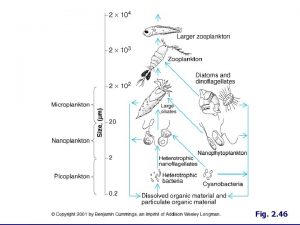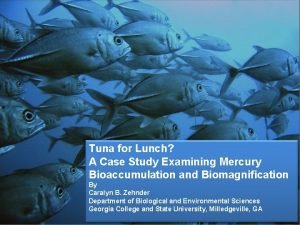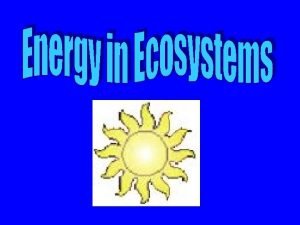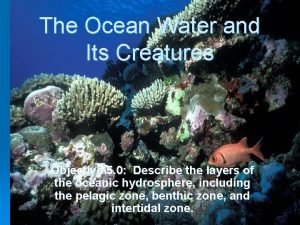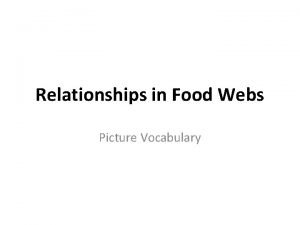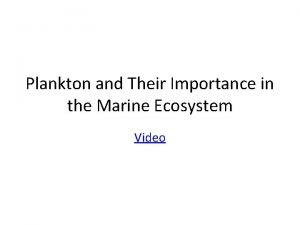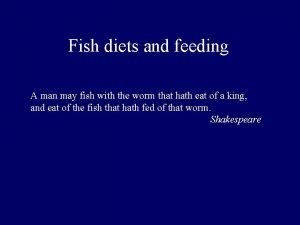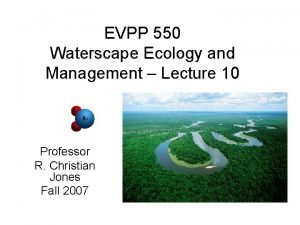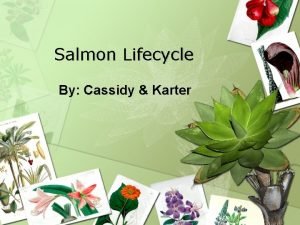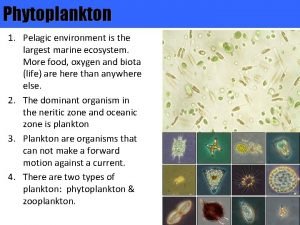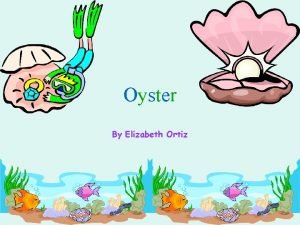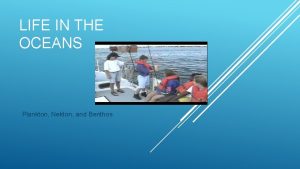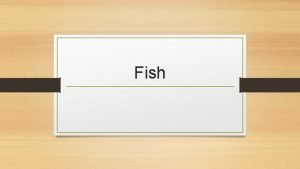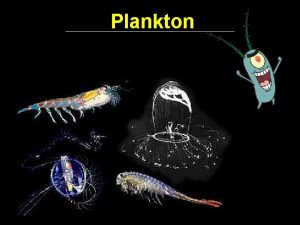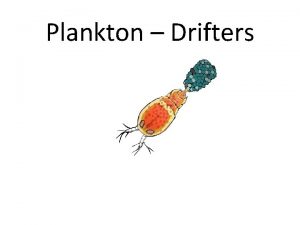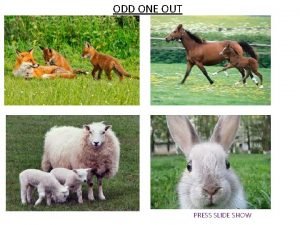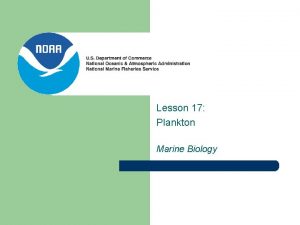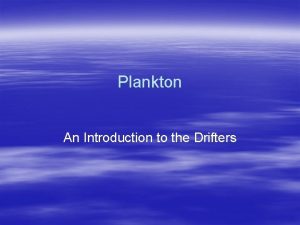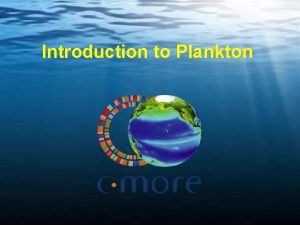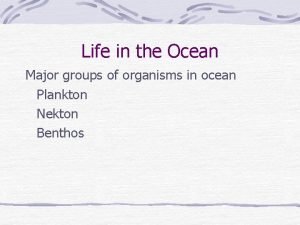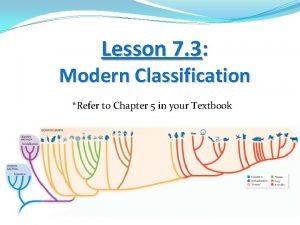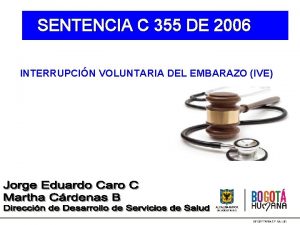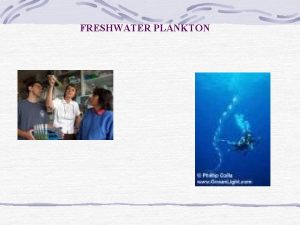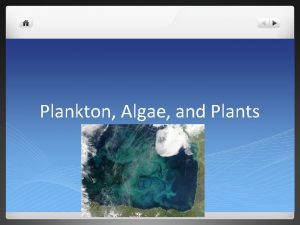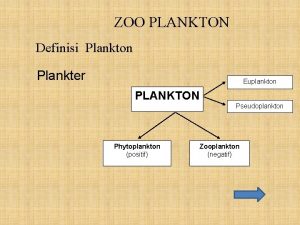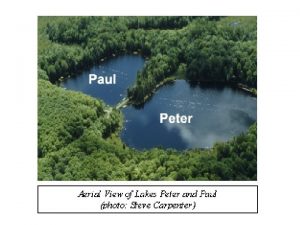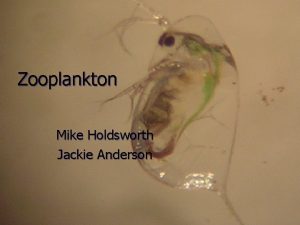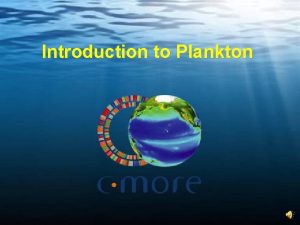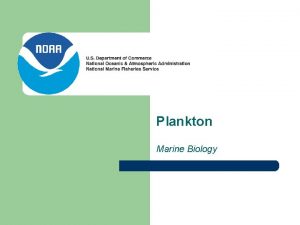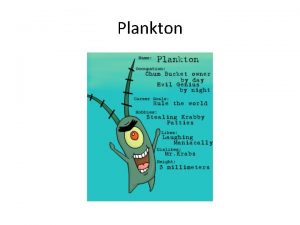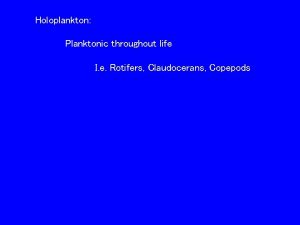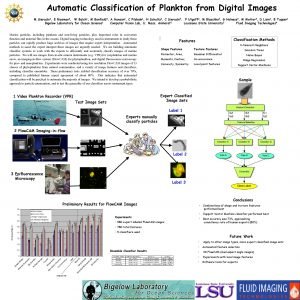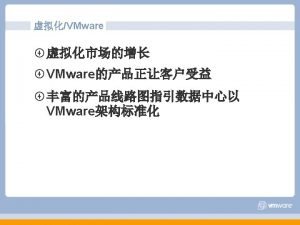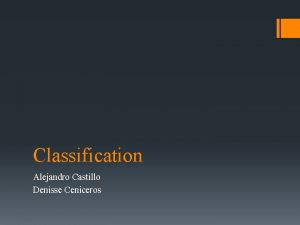Zooplankton Fall 2006 Plankton Classification Plankton Holoplankton Meroplankton










































- Slides: 42

Zooplankton Fall 2006

Plankton Classification Plankton Holoplankton Meroplankton

Plankton Classification Picoplankton (0. 2 – 2 µm) Plankton Nanoplankton (2 -20 µm) Microplankton (20 -200 µm) Mesoplankton (200 -2000 µm) Macroplankton (>2000 µm) Netplankton

Herbivore Carnivore Heterotrophs Plankton Omnivore Detritus Producers Mixotrophs Autotrophs

Viruses Bacteria Plankton Phytoplankton Protozoa Zooplankton

Viruses Bacteria Plankton Phytoplankton Protozoa Zooplankton

Zooplankton • Drifting animals, organisms that eat other plankton

ZOOPLANKTON • Animals that can swim and pursue prey. • Radiolarians, Foraminiferans • Crustacean – Copepods • Gelatinous – Salps, larvaceans, ctenophores, jellyfish, pteropods http: //pandora. ucsd. edu/jaffelab/people/celeste/Intro/

Why study them? • Most abundant animal on earth • Secondary producers in marine systems • Found in nearly every imaginable habitat • Critical step in marine food chains • Early life-stages of important commercial fish, shellfish • Important in nutrient cycling

Important Zooplankton Groups • Subclass Copepoda – Calanoide – Harpacticoids – Cyclopoids • Sub-Phylum Tunicata – Larvacea (pelagic appendicularians) – Thaliacea (salps, doliolids, pyrosomas)

Copepods • Phylum Arthropoda • Class Crustacea – – – Hard exoskeleton (chitin) Molt Jointed appendages 1 simple eye Small (0. 2 mm - >1 cm) Fecal pellets with a peritrophic membrane

Tunicates • Subclass Appendicularian • Subclass Salp • Subclass Doliolids – – – Gelatinous, soft bodies – carbohydrate Pelagic Pump water through filter nets Chordates (simple nervous system) Feed on a large size range of particles

Copepod-Images

Copepod-images

Gelatinous-images

Gelatinous-images

Gelatinous-images

Gelatinous-images

Other Zooplankton-images

Biological Carbon Pump CO 2 DOC Euphotic Depth DOC Fecal Pellets CO 2

Grazing • Clearance Rate = Grazing Rate: volume of water from which particles are completely removed – Efficiency: percent of particles remove (usually based on food quality or size) • Filtration Rate: total volume of water passing the filter apparatus per unit time – 1 copepod filters 1 l of water per h and that water has in it; – 50 um particles/l 100% efficiency - 10 -20 um particles/l 100% – 50 -2 um particles/l 10% – Clearance rate = 300 ml /copepod / h

Grazing (continued) • Ingestion Rate: amount of food passing through the gut per unit time – Units of chl, C or N • Filtration rates are related to food concentration Filter rate Food Conc.

Filtration Currents

Retention Size • Determined by the distance between the setae on maxillae of copepods – Carnivores >> herbivores /omnivores • Determined by the net spacing in tunicates

Efficiency Example

Grazing Types • Filtration: nonselective feeding, based on water currents • Raptorial: may or may not be selective: grab a food item – Mechanical reception – Chemosensory

Limitations / Preferences for Grazing – Size – Nutritional content – Taste – Concentration – Speed

Diel • Copepods: increased feeding at night • Tunicates: may or may not be diel

Seasonal • Maximum in the spring – Temperate areas (spring, fall, summer, winter) – Polar areas (spring, summer, fall, winter) – Food supply (concentration and type) – Life cycle of the zooplankter

Spring Summer Seasonal Grazing

Methods for Grazing • Clearance Experiments – Change in the number of cells during an incubation • Gut Pigment – Grazing on phytoplankton (depends on pigment destruction) • Tracers – Fluorescent-labels – Microcapsules – C-14, H-3 thymidine

Examples of Grazing Methods

Zooplankton • COPEPODS – Protozoa – Phytoplankton – Detritus • GELATINOUS –DOM –Colloids –Bacteria –Protozoa –Phytoplankton –detritus

Particles for Export and Food • What types of particles? – Feeding Appendages • Webs, houses • Gelatinous Zooplankton – Fecal Pellets

Excretion • Release of soluble material – Ammonia (Urea, free amino acids, DOC) – Younger stages excrete more per unit weight (Not total volume) – Decreases with temperature – Related to grazing

Egestion: Fecal pellet production • Release of solid material – High 7 -17 C: N – Copepods: surrounded by peritrophic membrane – Depends on food concentration to a point – Linear relationship between ingestion rate and pellet production rate – Temperature dependent FPPR / Pellet Volume Food Conc

Comparison between Copepods and Tunicates Activity Copepod Tunicate Grazing Filter Smaller particle size (5 -200) Raptorial feederselective Filter Large particle size (. 2 -200) Nonselective Digestion /assimilation Higher assimilation (30 -90%) Assimilation (1860%) Respiration Temperature temperature Egestion Conc c & N down Conc C & N up

Major Avenues of Focus Today • Controls on toxic blooms – Grazed or not? • Carbon cycle – Global warming – Grazing and flux of fecal pellets • Biodiversity – Genetic studies – Extreme environments • Human Health

Major Programs Around • Eurapp (European Appendicularians) • JGOFS (Joint Global Ocean Flux Study) • TASC (Trans-Atlantic Study of Calanus finmarchicus) • GLOBEC (Global ocean Ecosystem Dynamics)

• Nets Methods – 1 -size – Multiple size mesh – Multiple net frames • Acoustics • Cameras – In situ – Video • • Laser Diving Submersibles Fluorescence 1. Collection 1. Abundance 2. Distribution 3. Experiments 2. Observation 1. Behavior 2. Distribution

Methods-Experiments • • • Electrodes Chemical Analysis Molecular techniques Computers Internet

Zooplankton Ecology • Who is there? • What are they doing? • How are they doing it?
 Planktos greek
Planktos greek Zooplankton
Zooplankton Holoplankton
Holoplankton Plankton
Plankton Holoplankton
Holoplankton Tuna for lunch case study answers
Tuna for lunch case study answers Food chain zebra
Food chain zebra What secondary consumer eats zooplankton
What secondary consumer eats zooplankton Phytoplankton zooplankton
Phytoplankton zooplankton Climax community
Climax community Phytoplankton zooplankton
Phytoplankton zooplankton Phytoplankton zooplankton
Phytoplankton zooplankton A man may fish
A man may fish Cladocera characteristics
Cladocera characteristics Do shrimp eat plankton
Do shrimp eat plankton Photosynthetic phytoplankton
Photosynthetic phytoplankton Scientific name for oyster
Scientific name for oyster Plankton straining
Plankton straining What are plankton nekton and benthos
What are plankton nekton and benthos Plankton straining
Plankton straining Plankton grasshopper
Plankton grasshopper The word plankton comes from?
The word plankton comes from? Plankton is animal or plant
Plankton is animal or plant Plankton watch
Plankton watch Planktons
Planktons Plankton
Plankton Food chain of rabbit
Food chain of rabbit Plankton
Plankton Plankton
Plankton What exactly is plankton?
What exactly is plankton? Plankton
Plankton Epifuana
Epifuana Eager classification versus lazy classification
Eager classification versus lazy classification Semi tabulation presentation
Semi tabulation presentation Traditional classification vs modern classification
Traditional classification vs modern classification A real friend 2006
A real friend 2006 Sentencia c-355 de 2006
Sentencia c-355 de 2006 Pengiktirafan ukm 2006
Pengiktirafan ukm 2006 Monarch awards 2006
Monarch awards 2006 Syawal 2006
Syawal 2006 T. trimpe 2006 http://sciencespot.net/
T. trimpe 2006 http://sciencespot.net/ Mercedes quesada etxaide
Mercedes quesada etxaide C 355 de 2006
C 355 de 2006
